 W
WAndrena angustior is a Palearctic species of mining bee.
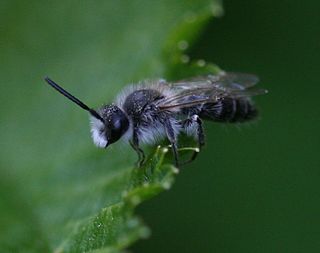 W
WThe bearded miner bee is a species of miner bee in the family Andrenidae. It is found in Europe & Northern Asia and North America. Other common names include the long-lipped andrena and the sandpit mining bee.
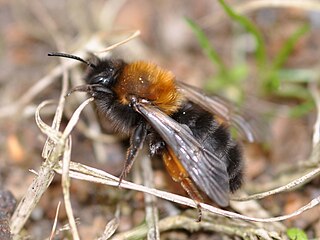 W
WThe Clark's miner bee is a species of miner bee in the family Andrenidae. Other common names include Clark's andrena and Clarke's mining bee. It is found in Europe & Northern Asia and North America.
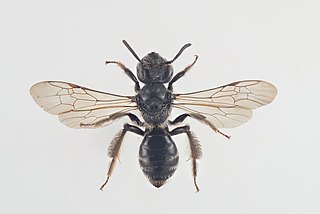 W
WAndrena coitana is a Palearctic species of mining bee.
 W
WAndrena denticulata is a Palearctic species of mining bee.
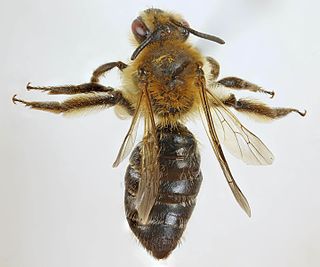 W
WAndrena fucata is a Palearctic species of mining bee.
 W
WAndrena fuscipes is a Palearctic species of mining bee.
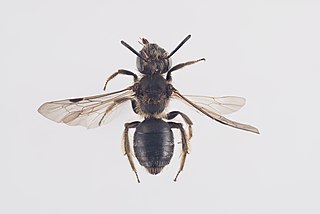 W
WAndrena minutula is a Palearctic species of mining bee.
 W
WAndrena nigroaenea is a Palearctic species of mining bee.
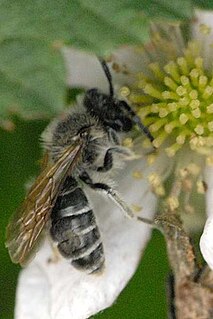 W
WAndrena ovatula is a Palearctic species of mining bee.
 W
WAndrena trimmerana, Trimmer's mining bee, is a species of mining bee from the family Andrenidae. It occurs in the western Palearctic but its true status in some areas is muddled due to issues of taxonomy and misidentification.
 W
WThe European legume miner bee is a species of miner bee in the family Andrenidae. Its original distribution is Europe. It has been accidentally introduced to North America long ago, possibly with ship ballast. It is active between April and August. Nests singly in group aggregations. Preferentially collects pollen from clover and sweet clover (Fabaceae).
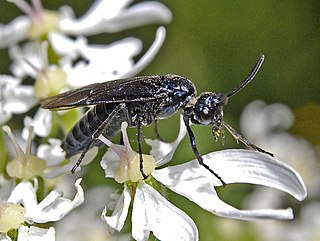 W
WArge berberidis, common name berberis sawfly, is a species of sawflies belonging to the family Argidae subfamily Arginae.
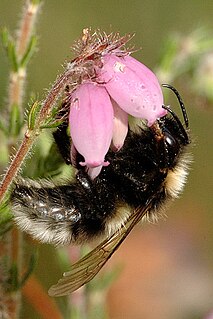 W
WBombus barbutellus, or Barbut's cuckoo-bee, is a species of cuckoo bumblebee, widespread, if not especially common, in most of Europe.
 W
WThe heath humble-bee or small heath bumblebee, Bombus jonellus, is a species of bumblebee, widely distributed in Europe and northern Asia, as well as northern North America.
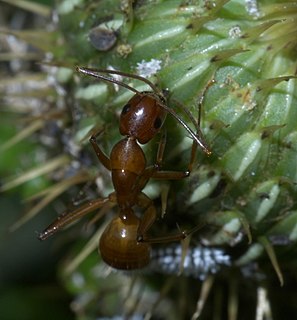 W
WCamponotus castaneus, the reddish carpenter ant, is a species of ant in the family Formicidae.
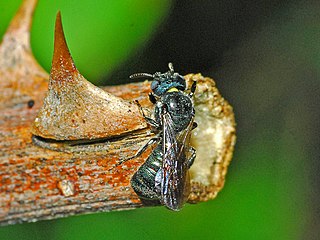 W
WCeratina cyanea, common name blue carpenter bee, is a species of bee belonging to the family Apidae, subfamily Xylocopinae.
 W
WChelostoma campanularum is a species of hymenopteran in the family Megachilidae. It is found in Europe & Northern Asia and North America.
 W
WCoelioxys inermis is a Palearctic species of thread-waisted wasp.
 W
WDaceton armigerum is a Neotropical species of arboreal ants, distributed throughout northern South America. D. armigerum combines several traits generally noted in some other arboreal ants i.e., populous colonies, large and/or polydomous nests, intra- and interspecific aggressiveness, trophobiosis, and capturing prey by spread-eagling them.
 W
WDinomyrmex is a monotypic genus of ant containing the species Dinomyrmex gigas or giant forest ant. D. gigas is a large species of ant, native to Southeast Asian forests. It is one of the largest ants in existence, measuring in at 20.9 mm (0.82 in) for normal workers, and 28.1 mm (1.11 in) for the soldiers. Honeydew makes up 90% of their diet, but they will also consume insects and bird droppings. The ant is an effective forager, utilizing both efficient communication and recruitment. A handful of these ants may meet at night to engage in what has been observed to be ritual battle. These fights can continue for several months.
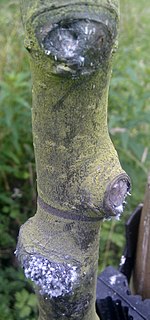 W
WEriosoma lanigerum, the woolly apple aphid, woolly aphid or American blight, is an aphid in the superfamily Aphidoidea in the order Hemiptera. It is a true bug and sucks sap from plants.
 W
WFormica pallidefulva is a species of ant found in North America. It is a red to dark brown ant with a shiny body, and varies in shade across its range. Colonies of this ant are found in a variety of habitats, where they excavate underground nests with galleries and chambers. In some parts of its range, the nests may be raided by slave-making ants, most notably Formica pergandei and Polyergus montivagus.
 W
WLabidus coecus is a species of army ant in the family Formicidae.
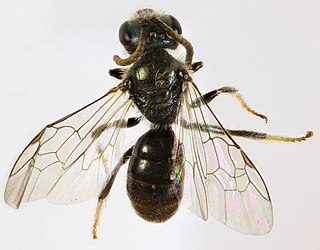 W
WLasioglossum leucopus is a Palearctic species of sweat bee.
 W
WLasioglossum malachurum, the sharp-collared furrow bee, is a small European halictid bee. This species is obligately eusocial, with queens and workers, though the differences between the castes are not nearly as extreme as in honey bees. Early taxonomists mistakenly assigned the worker females to a different species from the queens. They are small, shiny, mostly black bees with off-white hair bands at the bases of the abdominal segments. L. malachurum is one of the more extensively studied species in the genus Lasioglossum, also known as sweat bees. Researchers have discovered that the eusocial behavior in colonies of L. malachurum varies significantly dependent upon the region of Europe in which each colony is located.
 W
WLasioglossum nitidiusculum is a Palearctic species of sweat bee.
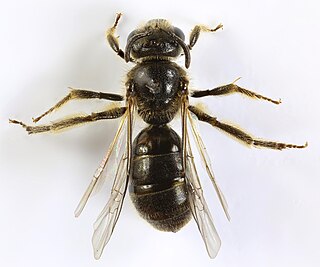 W
WLasioglossum villosulum is a Palearctic species of sweat bee.
 W
WThe longhorn crazy ant, also known as "black crazy ant", is a species of small, dark-coloured insect in the family Formicidae. These ants are commonly called "crazy ants" because instead of following straight lines, they dash around erratically. They have a broad distribution, including much of the tropics and subtropics, and are also found in buildings in more temperate regions, making them one of the most widespread ant species in the world. This species, as well as all others in the ant subfamily Formicinae, cannot sting.
 W
WManica rubida is a species of ant in the subfamily Myrmicinae.
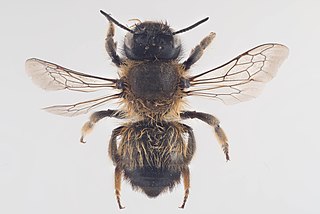 W
WMegachile circumcincta is a species of bee in the family Megachilidae. It was described by William Kirby in 1802.
 W
WMegachile ligniseca is a species of bee in the family Megachilidae. It was described by William Kirby in 1802.
 W
WMegachile maritima, common name coast leaf-cutter, is a species of leaf-cutter bees in the family Megachilidae. It was described by William Kirby in 1802.
 W
WMegachile willughbiella, Willughby's leaf-cutter bee is a species of bee in the family Megachilidae. It was described by the English entomologist William Kirby in 1802; he named it in honour of the ornithologist Francis Willughby.
 W
WMegaponera analis is the sole species of the genus Megaponera. They are a strictly termite-eating (termitophagous) ponerine ant species widely distributed in Sub-Saharan Africa and most commonly known for their column-like raiding formation when attacking termite feeding sites. Their sophisticated raiding behaviour gave them the common name Matabele ant after the Matabele tribe, fierce warriors who overwhelmed various other tribes during the 1800s. With some individuals reaching up to 25 millimetres (0.98 in) in length, M. analis is one of the world's largest ants.
 W
WMyrmecina graminicola is a species of ant found throughout Northern Africa, Europe, Asia, and elsewhere in the Palearctic realm. Its colonies build nests in soil, under rocks, and in leaf litter. It was described in 1802 by Pierre André Latreille, initially in the genus Formica. They are not an aggressive species. When a worker encounters an intruder, it starts to play dead with its legs and antennae folded. They live in colonies that have less than 100 workers and one queen. Before mating, the female ant releases a pheromone that the male ant is attracted to this and the mating then occurs seconds after. The ant colonies move around following the queen’s pheromone trail.
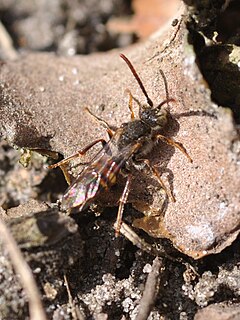 W
WNomada flavoguttata is a Palearctic species of nomad bee.
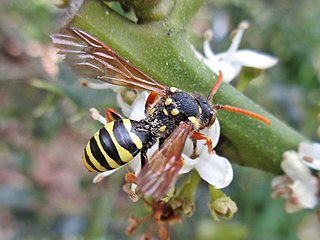 W
WNomada goodeniana is a Palearctic species of nomad bee.
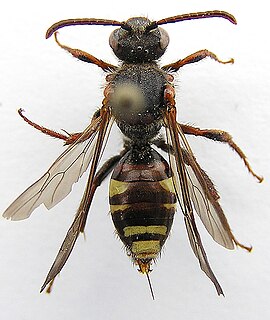 W
WNomada leucophthalma is a Palearctic species of nomad bee.
 W
WNomada marshamella, Marsham's nomad bee, is a species of Palearctic cuckoo bee which appears to be a wasp mimic and which is cleptoparasite on the mining bees of the genus Andrena, especially A. scotica and A. trimmerana.
 W
WNomada sheppardana is a Palearctic species of nomad bee.
 W
WOecophylla longinoda is a species of arboreal ant found in the forested regions of tropical Africa. They are one of only two extant species of the genus Oecophylla, the other being O. smaragdina. They make nests in trees made of leaves stitched together using the silk produced by their larvae.
 W
WPogonomyrmex badius, or the Florida harvester ant, is a species of harvester ant in the genus Pogonomyrmex. It is the only Pogonomyrmex species found on the east coast of the United States and the only one in North America known to be polymorphic. The species is ubiquitous in the Florida scrub habitats.
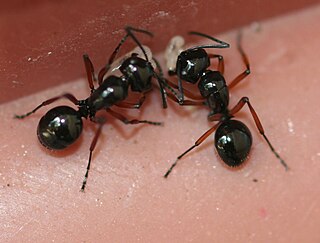 W
WPolyrhachis rastellata is a species of ant in the subfamily Formicinae, found in few Asian countries. Two subspecies are recognized. Some texts include many more subspecies ranks. but it is debatable about these ranks. The following two subspecies are according to AntWiki.org
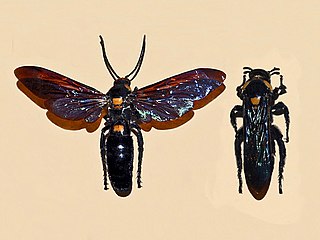 W
WScolia procera is a species of wasp belonging to the family Scoliidae.
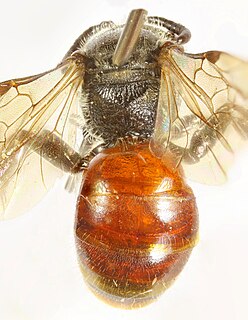 W
WSphecodes geoffrellus is a Palearctic species of sweat bee.
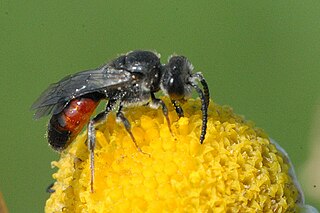 W
WSphecodes monilicornis is a Palearctic species of sweat bee.
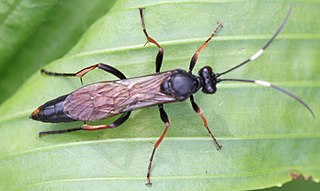 W
WStenichneumon culpator is a species of ichneumon wasp in the family Ichneumonidae.
 W
WStylops melittae is a species of the order Strepsiptera of flying insects, that parasitize various species of sand bees (Andrena).